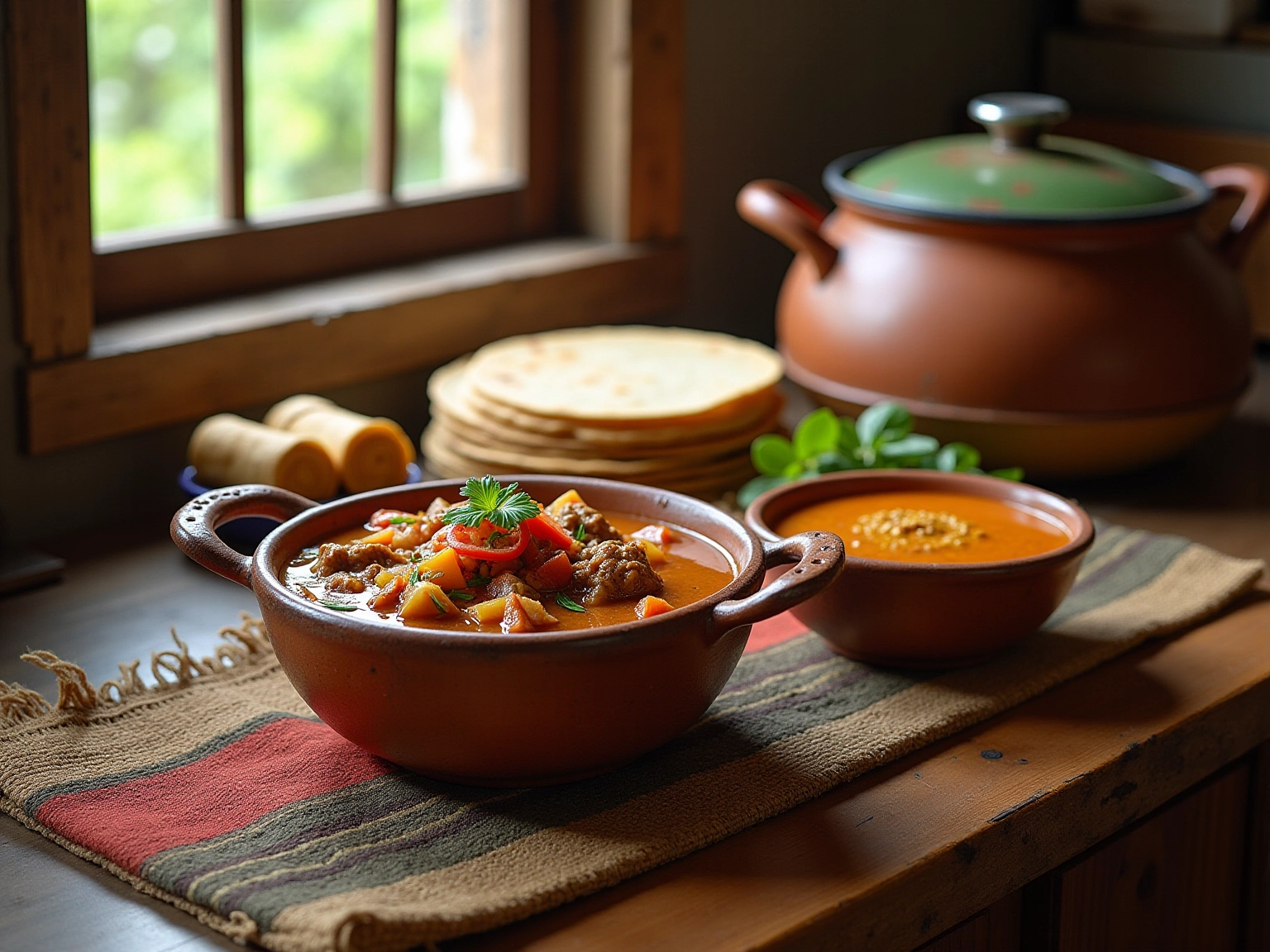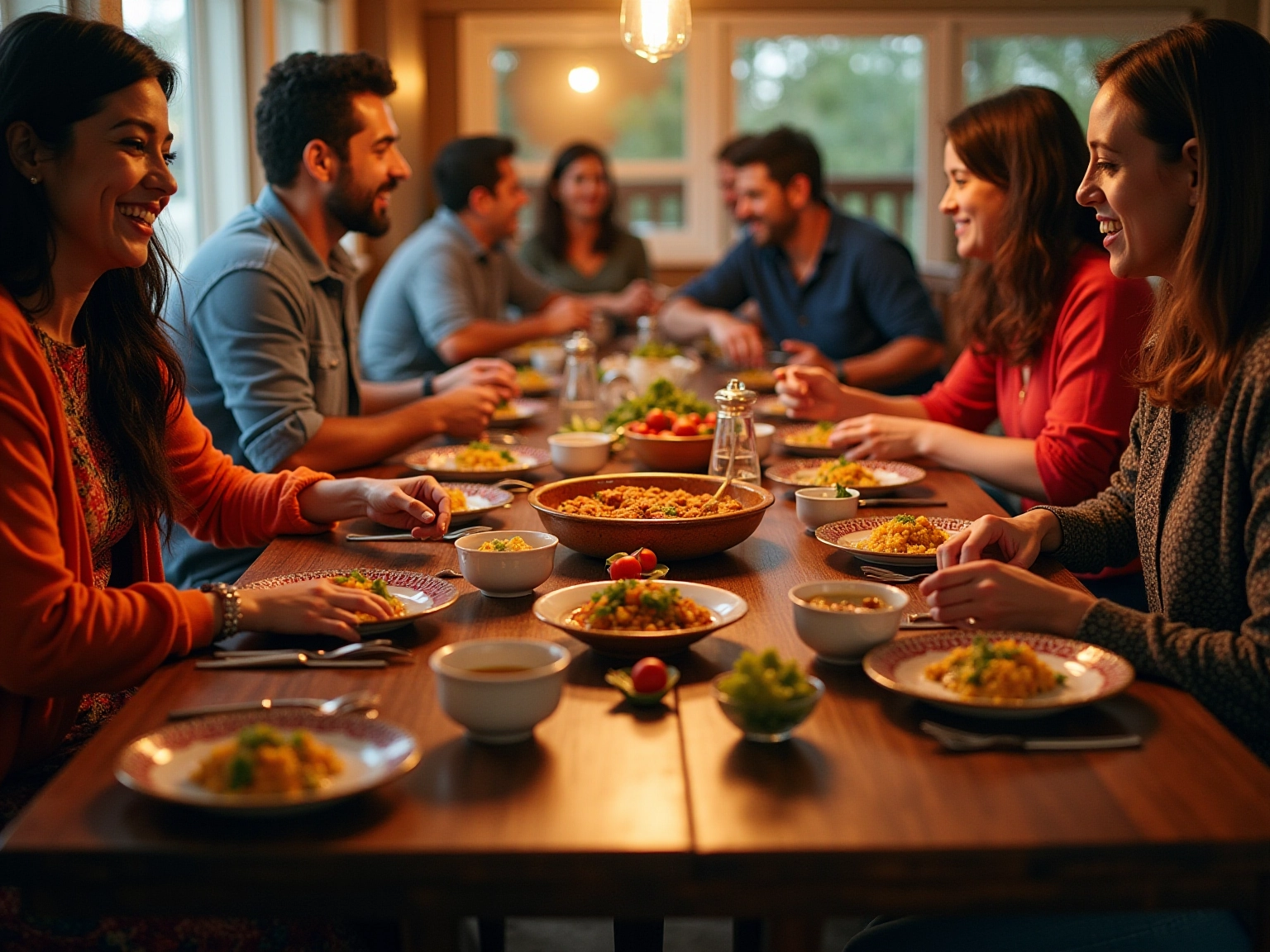Overview
Guatemalan cuisine is a delightful tapestry woven from staple ingredients like corn, beans, and chilies. These elements are foundational to traditional dishes, reflecting the country’s rich cultural heritage shaped by both ancient Maya and Spanish influences. When you think about food in Guatemala, it’s not just about sustenance; it’s a vibrant means of fostering community connections and preserving cultural identity. You can really feel this during communal dining practices and in the significance of iconic dishes like Pepián and Kak’ik, especially during celebrations!
Imagine sitting around a table with friends and family, sharing stories and laughter over a delicious meal. That’s the heart of Guatemalan dining! It’s all about connection and celebration, making every bite a part of a larger story. So, if you’re looking to dive into a culinary adventure, Guatemala’s food scene is waiting for you to explore its rich flavors and traditions. Trust me, it’s an experience you won’t want to miss!
Key Highlights:
- Guatemalan cuisine is deeply rooted in history, influenced by the ancient Maya civilization and Spanish colonization.
- Staple ingredients include corn, beans, and chilies, which form the foundation of traditional dishes.
- Meals are communal events that foster cultural connections and strengthen community bonds.
- Iconic dishes such as Pepián, Kak’ik, and tamales reflect the fusion of indigenous and Spanish culinary traditions.
- Regional variations in cuisine are influenced by geography, with distinct dishes emerging from highlands and coastal areas.
- Food plays a significant role in cultural celebrations, with dishes like Fiambre symbolizing heritage and community.
- Local markets and family-owned restaurants provide authentic culinary experiences, showcasing traditional Guatemalan flavors.
- Dining etiquette emphasizes respect and community, with practices such as waiting for the host to start eating and sharing meals family-style.
Introduction
Guatemalan cuisine is so much more than just a collection of recipes; it’s a vibrant reflection of the country’s rich cultural heritage, shaped by centuries of history and tradition. Can you imagine the flavors that come from the ancient Maya civilization’s agricultural practices blended with the colorful influences of Spanish colonization? Each dish is a testament to the resilience and creativity of its people, telling a unique story. Whether it’s the communal joy of sharing a bowl of Pepián or the comforting warmth of Kak’ik during family gatherings, these meals create connections.
As our world becomes more interconnected, the significance of food in fostering cultural appreciation and community bonds shines brighter than ever! This exploration of Guatemalan cuisine invites you to embark on a sensory journey through its iconic dishes, essential ingredients, and the cultural narratives that make it a truly unique culinary experience. Let’s dive in and discover the delicious stories waiting for you!
Understanding Guatemalan Cuisine: A Cultural Perspective
The food in Guatemala is a vibrant tapestry of flavors and traditions, deeply rooted in the country’s rich history. It’s fascinating how the ancient Maya civilization shaped this culinary landscape, establishing corn, beans, and chilies as staples. These ingredients are not just common food in Guatemala; they reflect the region’s agricultural heritage and serve as the foundation for many beloved traditional dishes.
Spanish colonization added even more richness to this culinary identity, bringing in new flavors, cooking techniques, and ingredients that blend seamlessly with local cuisine.
But the significance of food in Guatemala extends beyond mere nourishment; it’s a way to express culture and connect communities. Meals often become communal occasions, where families and friends gather to enjoy common food, strengthening bonds and preserving heritage. Take Tukun-ik, for example—a cherished corn, egg, and chili soup that’s a staple in San Juan. It highlights local ingredients and cooking traditions passed down through generations.
Recent developments, like the rise of cultural activities in Antigua due to foreign university programs and language institutes, have further spotlighted the role of food in cultural engagement. These initiatives enhance the local arts and humanities scene, fostering a greater appreciation for the culinary arts among both residents and visitors. As Simone Riddle aptly noted, “No me vas a depreciar Simone,” capturing the pride in local food traditions.
Moreover, modern challenges, such as the March for Water on April 22, 2016, showcase the resilience of these food traditions. As the nation faces issues like escalating water disputes, the enduring legacy of the Maya civilization and the adaptability of its people shine through their culinary practices. This rich gastronomic heritage, exemplified by common food in Guatemala, nourishes both body and soul, acting as a vital connection to Guatemala’s identity.
Traditional Staples: Key Dishes of Guatemala
The cuisine of Guatemala is like a vibrant tapestry, woven from its rich cultural heritage, showcasing the common foods that embody the essence of this beautiful nation. At the forefront is Pepin, a hearty meat stew often hailed as the national dish! It’s celebrated for its complex flavors and historical significance. This dish beautifully reflects the fusion of indigenous and Spanish culinary traditions, featuring local ingredients and spices that have been lovingly passed down through generations.
Another cornerstone of Guatemalan gastronomy is Kak’ik, a traditional turkey soup known for its spicy broth and aromatic herbs. This dish is not just a comforting meal; it emphasizes the importance of turkey in local culture, often enjoyed during family gatherings and festive occasions.
Tamales are another staple that accompanies many meals. Made from masa (corn dough) and filled with a variety of ingredients, these versatile treats can be stuffed with meats like beef, chicken, pork, turkey, or lamb. They’re often enjoyed during celebrations, embodying the communal spirit of Guatemalan dining. And let’s not forget tortillas! They elevate the dining experience, providing a perfect way to savor the rich flavors of the main courses.
Together, these delightful foods represent the common cuisine of Guatemala. They not only nourish the body but also tell the story of the country’s agricultural heritage and communal dining traditions. They are vital to the nation’s gastronomic identity, reflecting the diverse influences of Spanish, Mayan, and Afro-Caribbean cultures that shape its food culture. As you explore this region, indulging in these traditional dishes offers a deeper connection to the local culture and the fascinating stories behind each recipe. Isn’t that exciting?

Iconic Guatemalan Dishes You Must Try
When you dive into the culinary landscape of Guatemala, you’ll find several iconic dishes that are essential experiences for any food lover. One standout is ‘Pepián,’ a thick and spicy meat stew that dazzles with its intricate flavors and rich history. It beautifully reflects the blend of indigenous and Spanish influences that shape Guatemala’s culinary traditions. Often prepared with various meats and a mix of spices, this dish creates a rich tapestry of taste that generations have cherished.
Its cultural significance shines through during traditional celebrations and family gatherings, making it a true symbol of heritage from the region.
Another must-try is Kak’ik, a traditional turkey soup that connects you directly to the country’s indigenous roots. This vibrant red broth, infused with herbs and spices, showcases the deep cooking traditions of the Maya, making it a staple in local homes.
Then there’s Jocón, a green chicken stew made with tomatillos and cilantro. It offers a refreshing contrast with its bright flavors and is often served during festive occasions. And let’s not forget Hilachas, a shredded beef dish served with potatoes and carrots, exemplifying the hearty comfort food found in the region’s kitchens. Over time, this dish has evolved, incorporating various ingredients while maintaining its essence as a beloved family meal.
Each of these dishes not only tantalizes your palate but also provides a unique insight into Guatemala’s rich culinary traditions. The common food here is deeply rooted in ancient Mayan heritage and Spanish colonial influences, with traditional meals often featuring staples like corn, black beans, and tropical fruits. Emphasizing authentic local food truly enhances your travel experience, allowing you to connect with the culture through its diverse and flavorful offerings.
As you indulge in these iconic dishes, you embark on a gastronomic journey that celebrates the artistry and heritage of Guatemalan cuisine. Just ask Tiffany, who exclaimed after trying the Quesabirria at Tacos Don Juan, “WOW!! That was the best taco yet!”
This personal experience highlights the profound impact of local cuisine on travelers. Plus, The Design Tourist has been recognized with NATJA Gold and Bronze Awards for excellence in travel journalism, reinforcing the quality and authority of the content provided.
Essential Ingredients in Guatemalan Cooking
When you think of Guatemala, imagine the rich tapestry of flavors that make up its culinary landscape! Essential ingredients like corn, beans, and chilies are the heart and soul of Guatemalan cooking, forming the foundation of its vibrant food heritage. Corn is everywhere—in tortillas, tamales, and even atole—making it a staple that plays a central role in daily meals and reflects its cultural significance.
Beans, known for their high protein content, are often served as a side dish, enhancing the diverse flavors of the cuisine. And let’s not forget about chilies! Whether fresh or dried, they add that essential kick to soups, stews, and salsas, bringing complexity and excitement to every bite. Tomatoes contribute acidity and sweetness, while cilantro adds a fresh, aromatic touch. Spices like achiote and cumin further enrich the culinary scene, deepening the flavors of traditional recipes.
Did you know that in 2011, nearly 25% of groceries in Guatemala were bought in supermarkets? This highlights how accessible these essential ingredients are! Recent features on The Design Tourist have showcased the delightful food culture of Guatemala, illustrating how these staples come to life in everyday cooking. A study titled “Comparison of Nutritional Declarations in Central American Products” found that while local products often lack detailed labeling, the nutritional value of staples like corn, beans, and chilies is undeniably significant.
These ingredients not only provide essential nutrients but also tell the story of Guatemala’s culture through its food. Experts emphasize the importance of these staples for enhancing health and wellness in the country’s diet. As noted by Manuel Ramirez-Zea from the INCAP Research Center for the Prevention of Chronic Diseases, “We photographed nutrition labels of pre-packaged foods,” highlighting the need to understand nutritional quality. Incorporating corn, beans, and chilies into your meals is a delicious way to support a balanced diet rich in essential vitamins and minerals.
Understanding these ingredients is key to appreciating the complexity and richness of Guatemalan cuisine, which continues to evolve while honoring its traditional roots. So, are you ready to dive into this culinary adventure? Let’s explore the flavors of Guatemala together!
Regional Variations: How Geography Shapes Guatemalan Cuisine
Guatemalan cuisine is like a vibrant tapestry, beautifully woven from the diverse landscapes of the country, leading to some truly exciting regional variations! In the highlands, for instance, you’ll find hearty staples like potatoes and corn thriving in the cooler climate. On the flip side, the coastal regions celebrate the bounty of the sea, offering a delightful array of seafood paired with tropical fruits that flourish in the warm, humid air.
One dish that stands out is Chuchitos—these smaller, firmer tamales wrapped in dried corn husks are commonly served at luncheons, dinners, and celebrations. They really showcase how local ingredients and traditions shape the food scene, don’t you think?
You’ll notice the influence of local agriculture in the distinct herbs and spices that different regions favor. For example, in the Caribbean-influenced areas, coconut and plantains take center stage, reflecting the unique tropical agricultural practices of those locales. This geographical diversity not only enriches [the culinary landscape](https://eliteplusmagazine.com/Article/1080/ Guatemalan_Cuisine__A_rich_tapestry_of_gastronomic_traditions) but also offers you a wonderful opportunity to explore the intricate connections between the land and its flavors.
Experts agree that these regional variations are not just about personal preference; they’re deeply rooted in the agricultural practices and cultural traditions of each area. A fascinating case study on pulse crop losses in the region highlights the challenges faced in the food supply chain, revealing how geographical factors can impact food availability and quality. Such insights really illustrate the broader effects of geography on food variety, making Guatemala an intriguing destination for anyone eager to dive into its rich gastronomic heritage.
As Shirley Aguilar, the HE Ambassador, aptly puts it, “modern cuisine from the region reflects [a dynamic culinary scene](https://eliteplusmagazine.com/Article/1080/ Guatemalan_Cuisine__A_rich_tapestry_of_gastronomic_traditions) that honors tradition while embracing innovation and creativity.” So, are you ready to explore the flavors of Guatemala?
Cultural Significance of Food in Guatemala
In Guatemala, food is more than just sustenance; it’s a vibrant expression of heritage and community, especially during traditional celebrations and family gatherings. Think of the meticulously prepared dishes that grace significant events like weddings, birthdays, and religious festivals. They reflect the rich tapestry of Guatemalan culture! A prime example is Fiambre, a delightful cold salad made with a variety of meats and vegetables, traditionally served during the Day of the Dead celebrations. This dish not only tantalizes your taste buds but also embodies the spirit of remembrance and honor for loved ones who have passed.
Food has this magical ability to foster connections and create lasting memories. When you share meals, especially common food in Guatemala, you strengthen familial bonds and reinforce your identity. It’s fascinating how cooking practices can enhance the overall travel experience! Studies show that the joy of preparing and enjoying food during celebrations is deeply tied to community values and heritage.
The significance of common food in Guatemala has gained attention from international universities and language schools in Antigua since 1978, sparking a resurgence of local cooking traditions. This growing cultural activity highlights how food connects travelers with [the local culture](https://eliteplusmagazine.com/Article/1080/ Guatemalan_Cuisine__A_rich_tapestry_of_gastronomic_traditions), deepening their understanding and appreciation of life in the region. Through these gastronomic experiences, you can connect more profoundly with the narratives and customs that characterize this vibrant nation, including its common food.
Speaking of local produce, did you know that the vegetable yield is around X tonnes per hectare? This underscores the importance of fresh, local ingredients in traditional dishes. As Alfred Jensen, a talented painter and printmaker from Guatemala, pointed out, the bond between culture and food is profound, reflecting the essence of its identity. Just like the case study of Hanoi’s Old Quarter illustrates how historical and societal elements create engaging travel experiences, the culinary practices in Guatemala deepen connections between travelers and local traditions.
So, as you savor these shared meals and traditions, you’ll truly appreciate [[the rich cultural narrative](https://eliteplusmagazine.com](https://eliteplusmagazine.com/Article/1080/ Guatemalan_Cuisine__A_rich_tapestry_of_gastronomic_traditions)/Article/1080/ Guatemalan_Cuisine__A_rich_tapestry_of_gastronomic_traditions) that food signifies in this beautiful Central American country!
Where to Experience Authentic Guatemalan Cuisine
To truly savor authentic dishes and appreciate the local flavors in Guatemala, you should dive into the vibrant atmosphere of local markets and family-owned restaurants. Mercado Central in Guatemala City is a fantastic food hub where you can explore a diverse array of traditional foods. Here, street vendors tempt you with mouthwatering tamales, while stalls serve up freshly made tortillas—both staples that showcase the rich flavors of the region.
In Antigua, dining spots like La Fonda de la Calle Real and Casa Santo Domingo not only offer delicious traditional dishes but also a charming ambiance that reflects the local culture. You’ll feel right at home!
Want to deepen your experience? Consider participating in cooking classes! These classes allow you to discover the cooking methods and ingredients that make up the beloved dishes of Guatemala. You’ll often uncover the stories behind cherished meals, fostering a deeper appreciation for the country’s culinary heritage.
The artistic scene in Antigua is thriving, thanks to the creation of International University programs and language schools. Events like scholarly conventions and book fairs have sparked greater engagement with the region’s history and culture, further elevating the significance of its cuisine. As Shirley Aguilar, the HE Ambassador, mentioned, “modern cuisine from that region reflects a dynamic food scene that honors tradition while embracing innovation and creativity.”
This evolving gastronomic landscape invites you to explore not just the flavors but also the cultural narratives that accompany each dish, creating a truly memorable experience. Plus, the epic Popol Vuh is seen as one of the most important documents of the pre-Columbian Americas, illustrating the deep historical roots of Guatemalan culture and its culinary traditions. This blog combines expert storytelling with [practical travel guidance](https://eliteplusmagazine.com/Article/1080/ Guatemalan_Cuisine__A_rich_tapestry_of_gastronomic_traditions), enriching [[your travel experiences](https://eliteplusmagazine.com/Article/1080/ Guatemalan_Cuisine__A_rich_tapestry_of_gastronomic_traditions)](https://eliteplusmagazine.com/Article/1080/ Guatemalan_Cuisine__A_rich_tapestry_of_gastronomic_traditions) and inspiring you to explore the vibrant food scene in Guatemala.
Dining Etiquette: Navigating Meals in Guatemala
Dining etiquette in the region is not just about food; it’s a beautiful blend of respect and tradition that reflects the rich heritage of the country. When you’re invited to share a meal, remember to wait for the host to start eating before you dig in. This practice shows respect and sets a lovely communal tone for the meal.
A key phrase to keep in mind is ‘Buen Provecho.’ You’ll often hear this exchanged among diners, wishing each other an enjoyable meal. It’s such a simple gesture, yet it fosters a sense of camaraderie and connection around the table.
Meals in the country are typically served family-style, which encourages sharing and vibrant conversation. This communal approach invites guests to engage with one another, enhancing the overall experience. Understanding these customs is essential for anyone looking to immerse themselves in Guatemalan heritage, as meals offer a wonderful opportunity for connection and exchange.
Statistics show that dining customs here are a reflection of the country’s values and social fabric. For example, the importance of sharing meals is evident in various societal practices, where food becomes a medium for storytelling and relationship-building. A recent case study titled “Discovering the Secrets: 10 Fun Things to Do in the Capital City” highlights how food experiences can significantly enhance visitors’ appreciation of local culture, encouraging exploration beyond just the plate.
Karen LeBlanc, through her work with The Design Tourist, emphasizes the value of authentic experiences in travel. Every meal can tell a story about the culture and traditions of a place, which is truly exciting! Carlos Merida, the most renowned painter from the country, once pointed out the significance of tradition in societal practices, resonating deeply with the dining customs in the region. By embracing these dining etiquettes and customs, you can transform your meals into meaningful interactions, enriching your journey through Guatemala’s vibrant culinary landscape.
As of 2025, The Design Tourist has published seven posts, continuing to empower readers with expert storytelling and practical travel advice. It’s a fantastic resource for anyone looking to connect with the cultural narratives of their destinations!

Conclusion
Guatemalan cuisine is a vibrant reflection of the country’s cultural heritage, shaped by centuries of history. Key ingredients like corn, beans, and chilies form the backbone of iconic dishes such as Pepián and Kak’ik, showcasing a unique blend of indigenous and Spanish influences. Each dish tells a story, revealing the resilience and creativity of the Guatemalan people.
But food in Guatemala goes beyond mere sustenance; it serves as a vital medium for cultural expression and community bonding. Sharing meals strengthens familial ties and reinforces cultural identity. Just think about traditional dishes like Fiambre during the Day of the Dead, which honor loved ones and celebrate togetherness.
As our world becomes more interconnected, the significance of Guatemalan cuisine in fostering cultural appreciation grows. Engaging with local food traditions—whether through visits to bustling markets, family-run restaurants, or hands-on cooking classes—provides you with a deeper connection to the culture. Savoring these flavors not only delights your palate but also enriches your understanding of Guatemala’s dynamic heritage.
By embracing the stories behind each dish, you can truly appreciate the artistry that defines Guatemalan cuisine. This culinary exploration invites you to partake in the delicious narratives that reflect the country’s history, community, and identity, making your experience truly memorable and unique.
Frequently Asked Questions
What are the staple ingredients in Guatemalan cuisine?
The staple ingredients in Guatemalan cuisine include corn, beans, and chilies, which reflect the region’s agricultural heritage.
How did Spanish colonization influence Guatemalan food?
Spanish colonization introduced new flavors, cooking techniques, and ingredients that blended with local cuisine, enriching the culinary identity of Guatemala.
What role does food play in Guatemalan culture?
Food serves as a way to express culture and connect communities, with meals often becoming communal occasions that strengthen bonds and preserve heritage.
Can you give an example of a traditional Guatemalan dish?
Tukun-ik is a cherished traditional dish, a corn, egg, and chili soup that highlights local ingredients and cooking traditions passed down through generations.
How have recent cultural activities impacted Guatemalan cuisine?
Recent cultural activities, particularly in Antigua due to foreign university programs and language institutes, have spotlighted the role of food in cultural engagement and fostered appreciation for the culinary arts.
What is Pepin, and why is it significant?
Pepin is a hearty meat stew considered the national dish of Guatemala, celebrated for its complex flavors and historical significance, reflecting the fusion of indigenous and Spanish culinary traditions.
What is Kak’ik, and what does it represent?
Kak’ik is a traditional turkey soup known for its spicy broth and aromatic herbs, emphasizing the importance of turkey in local culture, particularly during family gatherings and festive occasions.
What are tamales, and when are they typically enjoyed?
Tamales are made from masa (corn dough) and filled with various ingredients, often enjoyed during celebrations, embodying the communal spirit of Guatemalan dining.
How do tortillas complement Guatemalan meals?
Tortillas elevate the dining experience by providing a perfect way to savor the rich flavors of the main courses in Guatemalan cuisine.
What does the diverse food culture in Guatemala reflect?
The diverse food culture in Guatemala reflects the influences of Spanish, Mayan, and Afro-Caribbean cultures, showcasing the country’s agricultural heritage and communal dining traditions.


































